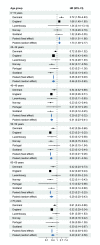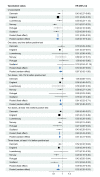A standardised protocol for relative SARS-CoV-2 variant severity assessment, applied to Omicron BA.1 and Delta in six European countries, October 2021 to February 2022
- PMID: 37676146
- PMCID: PMC10486193
- DOI: 10.2807/1560-7917.ES.2023.28.36.2300048
A standardised protocol for relative SARS-CoV-2 variant severity assessment, applied to Omicron BA.1 and Delta in six European countries, October 2021 to February 2022
Abstract
Several SARS-CoV-2 variants that evolved during the COVID-19 pandemic have appeared to differ in severity, based on analyses of single-country datasets. With decreased testing and sequencing, international collaborative studies will become increasingly important for timely assessment of the severity of new variants. Therefore, a joint WHO Regional Office for Europe and ECDC working group was formed to produce and pilot a standardised study protocol to estimate relative case-severity of SARS-CoV-2 variants during periods when two variants were co-circulating. The study protocol and its associated statistical analysis code was applied by investigators in Denmark, England, Luxembourg, Norway, Portugal and Scotland to assess the severity of cases with the Omicron BA.1 virus variant relative to Delta. After pooling estimates using meta-analysis methods (random effects estimates), the risk of hospital admission (adjusted hazard ratio (aHR) = 0.41; 95% confidence interval (CI): 0.31-0.54), admission to intensive care unit (aHR = 0.12; 95% CI: 0.05-0.27) and death (aHR = 0.31; 95% CI: 0.28-0.35) was lower for Omicron BA.1 compared with Delta cases. The aHRs varied by age group and vaccination status. In conclusion, this study demonstrates the feasibility of conducting variant severity analyses in a multinational collaborative framework and adds evidence for the reduced severity of the Omicron BA.1 variant.
Keywords: COVID-19; SARS-CoV-2; severity; study protocol; variant of concern; virulence.
Conflict of interest statement
Figures






References
-
- Bager P, Wohlfahrt J, Bhatt S, Stegger M, Legarth R, Møller CH, et al. Omicron-Delta study group . Risk of hospitalisation associated with infection with SARS-CoV-2 omicron variant versus delta variant in Denmark: an observational cohort study. Lancet Infect Dis. 2022;22(7):967-76. 10.1016/S1473-3099(22)00154-2 - DOI - PMC - PubMed
-
- Nyberg T, Ferguson NM, Nash SG, Webster HH, Flaxman S, Andrews N, et al. . Comparative analysis of the risks of hospitalisation and death associated with SARS-CoV-2 omicron (B.1.1.529) and delta (B.1.617.2) variants in England: a cohort study. Lancet. 2022;399(10332):1303-12. 10.1016/S0140-6736(22)00462-7 - DOI - PMC - PubMed
-
- Peralta-Santos A, Rodrigues EF, Moreno J, Ricoca V, Casaca P, Fernandes E, et al. Omicron (BA.1) SARS-CoV-2 variant is associated with reduced risk of hospitalization and length of stay compared with Delta (B.1.617.2). medRxiv. 2022:2022.01.20.22269406.
-
- Sheikh A, Kerr S, Woolhouse M, McMenamin J, Robertson C, Simpson CR, et al. . Severity of omicron variant of concern and effectiveness of vaccine boosters against symptomatic disease in Scotland (EAVE II): a national cohort study with nested test-negative design. Lancet Infect Dis. 2022;22(7):959-66. 10.1016/S1473-3099(22)00141-4 - DOI - PMC - PubMed
MeSH terms
Supplementary concepts
Grants and funding
LinkOut - more resources
Full Text Sources
Medical
Miscellaneous
